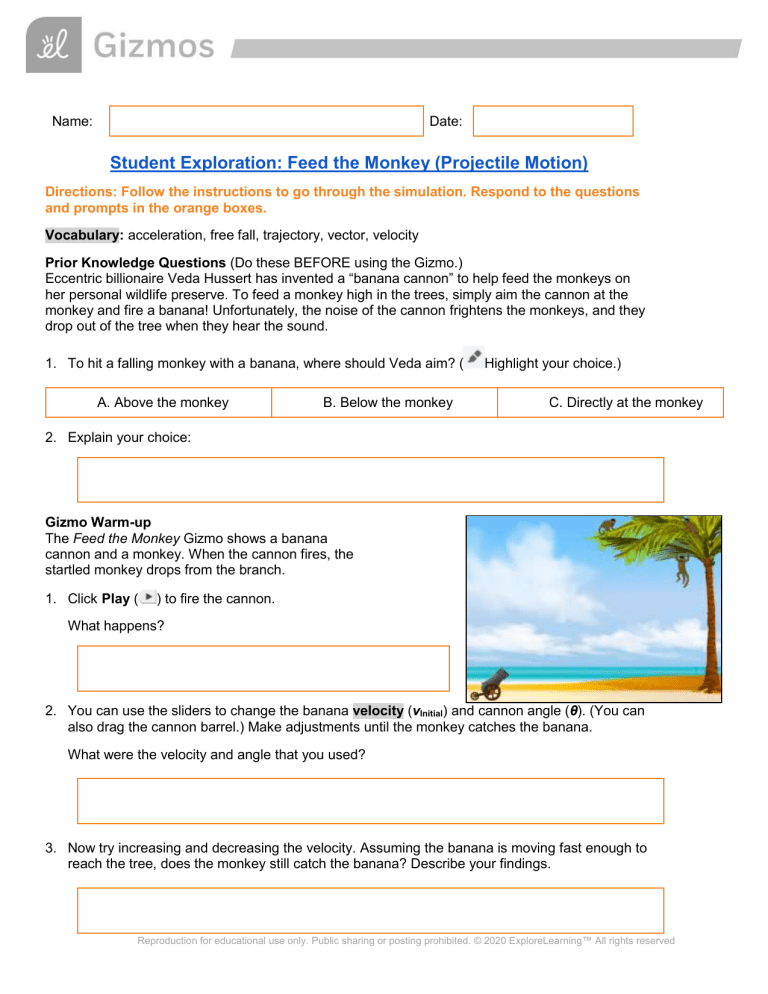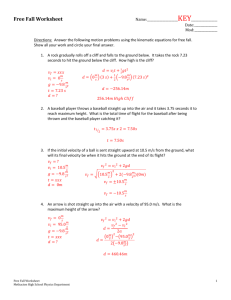
Name: Date: Student Exploration: Feed the Monkey (Projectile Motion) Directions: Follow the instructions to go through the simulation. Respond to the questions and prompts in the orange boxes. Vocabulary: acceleration, free fall, trajectory, vector, velocity Prior Knowledge Questions (Do these BEFORE using the Gizmo.) Eccentric billionaire Veda Hussert has invented a “banana cannon” to help feed the monkeys on her personal wildlife preserve. To feed a monkey high in the trees, simply aim the cannon at the monkey and fire a banana! Unfortunately, the noise of the cannon frightens the monkeys, and they drop out of the tree when they hear the sound. 1. To hit a falling monkey with a banana, where should Veda aim? ( A. Above the monkey B. Below the monkey Highlight your choice.) C. Directly at the monkey 2. Explain your choice: Gizmo Warm-up The Feed the Monkey Gizmo shows a banana cannon and a monkey. When the cannon fires, the startled monkey drops from the branch. 1. Click Play ( ) to fire the cannon. What happens? 2. You can use the sliders to change the banana velocity (vInitial) and cannon angle (θ). (You can also drag the cannon barrel.) Make adjustments until the monkey catches the banana. What were the velocity and angle that you used? 3. Now try increasing and decreasing the velocity. Assuming the banana is moving fast enough to reach the tree, does the monkey still catch the banana? Describe your findings. Reproduction for educational use only. Public sharing or posting prohibited. © 2020 ExploreLearning™ All rights reserved Activity A: Banana catchers Get the Gizmo ready: ● Click Reset ( ). ● Set the initial velocity (vInitial) to 26.0 m/s. Question: Where should you aim to hit the monkey with a banana? 1. Experiment: Turn on Show target line. Experiment with the Gizmo, trying several different cannon locations and launch angles. Try aiming above, below, and directly at the monkey. A. What always happens when you aim above the monkey’s head? B. What always happens when you aim below the monkey’s feet? C. What always happens when you aim at the monkey’s body? 2. Predict: How do you think changing the banana velocity will affect your results? 3. Test: Click Reset. Turn on Show grid, and drag the cannon to the point (25, 0.0) on the grid. Aim the cannon at the monkey, and try vInitial values of 15.0, 20.0, 25.0, and 30.0 m/s. How did the banana velocity affect the results of the experiment? 4. Observe: Click Reset, and turn on Show path. Drag the cannon to (0.0, 16.0) so that it is at the same level as the monkey. Set vInitial to 25.0 m/s, and θ to 0.0 degrees. Click Play. The lines represent the trajectories, or paths, of the banana and monkey. The dots on the lines show positions every 0.15 seconds. Compare the dots for the banana and monkey. A. What do you notice about the height of the dots on each trajectory? B. At any given time, what can you say about the heights of the banana and monkey? Reproduction for educational use only. Public sharing or posting prohibited. © 2020 ExploreLearning™ All rights reserved Activity B: Velocity vectors Get the Gizmo ready: ● Click Reset, and drag the cannon to the ground. ● Turn off Show grid and Show path. ● You will need a scientific calculator for this activity. Introduction: Velocity is an example of a vector quantity because it describes the speed and direction of an object. The velocity of an object through space can be shown by two components: a horizontal component (vx) and a vertical component (vy). Question: How does the velocity of an object change as it flies through space? 1. Observe: Turn on Show velocity components, and set θ to 45.0 degrees. Click Play, and focus on the blue and red arrows that represent the vertical and horizontal components of the banana’s velocity. A. As the banana flies through space, what do you notice about the blue (vertical) arrow? B. As the banana flies through space, what do you notice about the red (horizontal) arrow? C. Try other velocities and launch angles. Do these results hold up? 2. Calculate: You can use trigonometry to find the initial horizontal and vertical components of the banana’s velocity. Take out your calculator now. Click Reset, and turn off Show velocity components. Set vInitial to 20.0 m/s and θ to 60.0 degrees. A. To calculate vx, multiply vInitial by the cosine of the angle: vx = vInitial • cos(θ): B. To calculate vy, multiply vInitial by the sine of the angle: vy = vInitial • sin(θ): C. Turn on Show velocity vectors. Were you correct? 3. Analyze: An object flying through the air is said to be in free fall. As you observed, the horizontal component of velocity (vx) does not change as the object moves, but the vertical component (vy) decreases over time. (Note: Air resistance is not included in this model.) A. What force causes vy to change as the banana travels? B. Why doesn’t vx change as the object travels? (Hint: Are there any horizontal forces on the banana after it leaves the cannon?) Reproduction for educational use only. Public sharing or posting prohibited. © 2020 ExploreLearning™ All rights reserved 4. Set up Gizmo: Acceleration is a change in velocity. Both the banana and monkey undergo a downward acceleration due to the force of gravity. To calculate the acceleration of a falling object, divide the velocity change by the time interval. a = (vCurrent - vInitial) / t Check that vInitial is set to 20.0 m/s and θ to 60.0 degrees. Record the initial vertical velocity of the banana and monkey in the first row of the table below. Time vy (banana) vy (monkey) 0.00 5. Gather data: Click Play, and then click Pause ( ) before the monkey and banana hit the ground (or each other). Record the time, vy (banana), and vy (monkey) in the second row of the table above. 6. Calculate: For each object, calculate the velocity difference by subtracting the initial velocity from the final velocity (your answer should be a negative number). Then divide these numbers by the time to find the acceleration of each object. (Units of acceleration are m/s2.) Banana velocity change: Monkey velocity change: Banana acceleration: Monkey acceleration: 7. Analyze: What do you notice about the banana and monkey’s acceleration? 8. Think and discuss: Based on what you have learned about velocity and acceleration in this lesson, why should you aim directly at the monkey if you want it to catch the banana? Reproduction for educational use only. Public sharing or posting prohibited. © 2020 ExploreLearning™ All rights reserved





